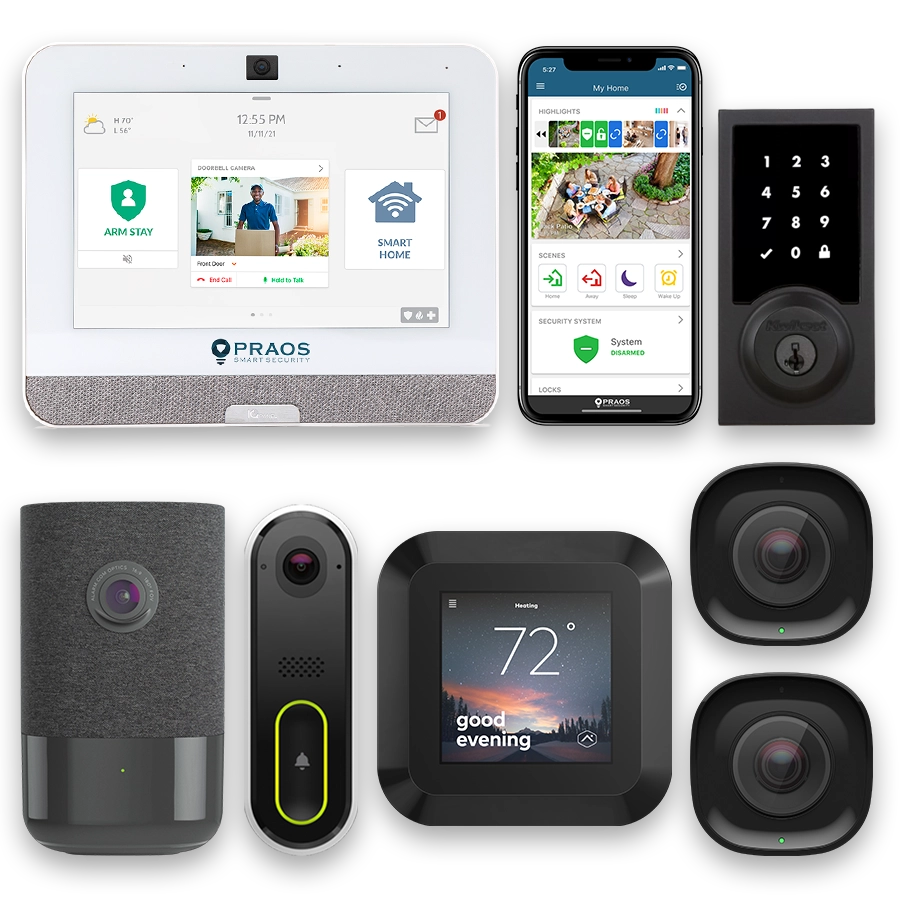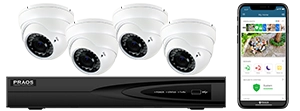Understanding Alarm Monitoring Plans
Alarm monitoring plans play a crucial role in ensuring the safety and security of your home or business. To make an informed decision, it is essential to have a clear understanding of what these plans entail and the various components involved.
Alarm monitoring involves a third party service that actively oversees security systems, including burglar alarms, fire alarms, and surveillance cameras. When these systems detect an issue, such as an intrusion, smoke, or suspicious activity, the monitoring service is alerted and can act swiftly, often by contacting emergency services and notifying the property owner.
One of the key components of an alarm monitoring plan is the central monitoring station. This facility operates 24/7 and is staffed with trained professionals who respond to alerts generated by security systems. Central stations are equipped with advanced technology to ensure quick and efficient responses to potential threats.
Another important element to consider is the type of communication used between the security system and the central monitoring station. Common communication methods include:
- Landline: Uses traditional telephone lines to send alerts. While reliable, it can be vulnerable to line cuts.
- Cellular: Utilizes mobile networks to transmit signals. This method is more secure against tampering but may incur additional costs.
- Broadband: Sends alerts via an internet connection. It offers high-speed communication but may be affected by internet outages.
Alarm monitoring plans can also vary based on the level of service they provide. Basic plans might include monitoring for burglar alarms only, while more comprehensive plans cover fire alarms, carbon monoxide detectors, and even medical alerts. Some services also offer live video monitoring where operators can view real-time footage from security cameras.
Understanding the distinctions between different alarm monitoring plans is essential to selecting the right one for your needs. Key variables to consider include the type of incidents monitored, the communication method used, and the level of service provided.
Assessing Your Security Needs
Before selecting an alarm monitoring plan, it is crucial to assess your security needs. Understanding your specific requirements will ensure that you choose a plan that provides adequate protection. Several factors should be considered when conducting this assessment.
Identify Potential Risks
The first step is to identify potential risks specific to your location and circumstances. Consider the crime rate in your area, the type of neighborhood you reside in, and any past security incidents. This will help in determining the level of security you need.
Determine the Level of Monitoring Required
Alarm monitoring plans vary from basic to comprehensive. Basic plans may simply alert you, and a monitoring center when an alarm is triggered, while more advanced plans offer 24/7 monitoring with direct communication to emergency services. Assess whether you require basic monitoring or a higher level of service.
Assess Property Size and Layout
The size and layout of your property will influence the type and number of sensors needed. Larger properties or those with multiple entry points may require more comprehensive coverage. Evaluate whether the plan supports enough devices to cover all critical areas.
Consider Technology and Compatibility
Ensure that the monitoring plan is compatible with existing security systems or desired new technology. Some alarm plans offer compatibility with smart home devices, mobile apps for remote monitoring, and integration with other security systems.
Create a Checklist of Security Needs
Creating a concise checklist of your security needs can simplify the selection process. Below is an example table to help identify key considerations:
| Security Need | Considerations |
|---|---|
| Crime Rate | High or low; frequent or rare incidents |
| Property Size | Large, medium, or small; number of entry points |
| Monitoring Level | Basic, intermediate, or comprehensive |
| Technology | Compatibility with smart devices, mobile apps, etc. |
Consult with Security Experts
Finally, consulting with security professionals can provide insights specific to your situation. Experts can recommend plans tailored to your needs, addressing any potential blind spots or vulnerabilities.
Comparing Alarm Monitoring Services
When it comes to choosing the right alarm monitoring plan, understanding the services offered by various providers is crucial. Differences in monitoring services can significantly impact the effectiveness and reliability of your security system. Here, we will compare key aspects of alarm monitoring services to help you make an informed decision.
Types of Monitoring
Alarm monitoring services can be broadly classified into three main types:
- Professional Monitoring: This involves a third party monitoring center that is alerted when your alarm system is triggered. Trained personnel assess the situation and contact the appropriate emergency responders if necessary. Providers like ADT, Vivint, and SimpliSafe offer this type of monitoring.
- DIY Monitoring: With this option, you receive alerts directly on your smartphone or other devices and are responsible for contacting emergency services. This is often a more cost-effective option but requires a higher level of personal involvement.
- Self-Monitored Systems with Professional Backup: Some systems allow for self-monitoring with the option to add professional backup. This provides a balance between DIY flexibility and professional reliability.
Communication Methods
Effective alarm monitoring relies on robust communication methods. Here are some common types:
- Landline: Traditional and often more stable, landline monitoring uses your home phone line to communicate with the monitoring center. However, it can be vulnerable to tampering.
- Cellular: Cell-based systems use cellular networks to relay information. This method is generally considered more secure, as it is less susceptible to physical disruption.
- Broadband/Internet: Broadband-based systems use your internet connection for communication. This is faster than landline but can be disrupted by a power outage or internet service interruption.
- Dual-Path: Dual-path communication combines two of these methods (e.g., cellular and broadband) to ensure a more reliable connection.
Response Time
The response time of an alarm monitoring service is a critical factor. This is the time it takes for the monitoring center to respond once an alarm is triggered. Faster response times can lead to quicker emergency assistance. According to various studies, industry-leading companies like ADT and Frontpoint have some of the fastest response times in the industry, generally within seconds.
Customer Support
Quality customer support is essential for resolving issues quickly and ensuring your alarm system functions correctly. Providers like Brinks and ADT are known for strong customer support, offering 24/7 assistance, comprehensive FAQs, and live chat options. Reviews and ratings from organizations like the Better Business Bureau can also provide insight into a company’s customer service track record.
Contract and Flexibility
Different companies offer varying levels of flexibility in their contracts. While some services, like those provided by ADT, require long-term contracts (usually 36 months), others, such as SimpliSafe, offer month-to-month plans. Evaluate your own needs for flexibility against potential cost savings when considering longer-term commitments.
In summary, comparing alarm monitoring services requires careful consideration of the type of monitoring, communication methods, response time, customer support, and contract flexibility. By assessing these factors, you can select a service that best suits your security needs and preferences.
Evaluating the Cost of Alarm Monitoring Plans
When evaluating the cost of alarm monitoring plans, it is essential to consider several key factors that can significantly influence the overall expense. Understanding these cost components will help you make an informed decision without compromising on your security needs.
Monthly Monitoring Fees: The most apparent cost associated with alarm monitoring plans is the recurring monthly fee. This fee typically covers the continuous monitoring of your system by a professional monitoring center. Monthly fees can vary widely, ranging from as low as $15 to as high as $60 or more, depending on the level of service and the provider.
Installation Costs: Depending on the provider and the complexity of your alarm system, there may be an initial installation fee. Some companies offer professional installation services, which can range from $100 to $500 or more. Alternatively, some providers offer DIY installation options, which can reduce or even eliminate this cost.
Equipment Costs: The type and amount of equipment you require will also impact the overall cost. Basic packages may include essential components such as control panels, door/window sensors, and motion detectors. Advanced systems might incorporate additional devices like surveillance cameras, smart home integration, and environmental sensors (e.g., smoke or carbon monoxide detectors). The cost of the equipment can range from $200 to $1,500 or more, depending on your specific needs and preferences.
Activation Fees: Some alarm monitoring companies charge a one-time activation fee when you first enroll in their service. This fee can range from $0 to $199, depending on the provider and the terms of the contract.
Service Contracts: Many alarm monitoring plans require a contractual commitment that can range from one to five years. Longer contracts might offer lower monthly fees, but they can also include early termination charges if you decide to cancel before the contract period ends. It is essential to read and understand the terms and conditions of the service contract to avoid unexpected expenses in the future.
Additional Charges: Be aware of potential additional charges that may not be immediately apparent. These can include fees for enhanced services such as video monitoring, mobile app access, and system maintenance. Some companies may also charge extra for service calls or for replacing faulty equipment outside of warranty periods.
In conclusion, evaluating the cost of alarm monitoring plans requires a thorough examination of various factors and potential charges. By considering the monthly fees, installation costs, equipment expenses, activation fees, service contract terms, and additional charges, you can make an informed decision that aligns with your budget while meeting your security requirements.
Analyzing Additional Features and Technologies
When selecting an alarm monitoring plan, it’s crucial to consider the additional features and technologies that can enhance your security system’s effectiveness. These elements can provide added convenience, improve response times, and increase overall safety. Below are several features and technologies you may encounter:
1. Smart Home Integration
Many modern alarm systems offer smart home integration, allowing you to connect your security system with other smart home devices like lights, locks, thermostats, and cameras. This integration can be managed through a single app, offering convenience and centralized control.
- Voice Assistants: Compatibility with systems like Amazon Alexa, Google Assistant, or Apple HomeKit.
- Remote Access: Control your security system from anywhere using a smartphone app.
2. Video Surveillance
Adding video surveillance to your alarm monitoring plan can significantly enhance your security setup. Features to consider include:
- Live Streaming: View real-time footage from your security cameras via a mobile app or web portal.
- Cloud Storage: Store recorded video clips in the cloud for easy access and retrieval.
- Smart Alerts: Receive notifications triggered by motion detection or other pre-set criteria.
3. Environmental Monitoring
Some alarm systems can monitor environmental factors that pose a risk to your home or business. This includes:
- Smoke and Fire Detection: Sensors that alert you, and the monitoring center in case of fire or smoke.
- Carbon Monoxide Detection: Monitors for the presence of this dangerous gas.
- Flood Detection: Sensors that detect water leaks or flooding to prevent extensive property damage.
4. Mobile Alerts and Notifications
Mobile alerts keep you informed about the status of your alarm system. Notifications can include:
- Arming/Disarming: Alerts when your system is armed or disarmed.
- Breach Notifications: Immediate alerts if a breach is detected.
5. System Redundancy and Reliability
Evaluating the reliability and redundancy of your alarm monitoring system can ensure continuous protection. Key points include:
- Backup Power: Battery backups that keep your system running during power outages.
- Dual Path Communication: Systems that use both cellular and Wi-Fi connections for reliability.
6. Customer Support and Service
Consider the quality and availability of customer support when choosing a plan. Responsive and knowledgeable support can be crucial in emergencies. Factors to look for include:
- 24/7 Support: Round-the-clock access to customer service representatives.
- Professional Installation: Whether the company offers professional installation services.
By carefully analyzing these additional features and technologies, you can select an alarm monitoring plan that not only meets your basic security needs but also enhances the overall safety and convenience of your home or business.
Making an Informed Decision
When it comes to making an informed decision about choosing the right alarm monitoring plan for your needs, several factors should be taken into account to ensure you select the best possible option. Here are the critical steps you should follow:
1. Combine Information from Multiple Sources
Thoroughly review information from various alarm monitoring service providers. Consider resources such as consumer reviews, industry reports, and regulatory compliance records to get a broad perspective on each service’s reputation and effectiveness.
2. Prioritize Your Security Needs
By now, you should have assessed your security needs in detail. Revisit this assessment to ensure all your requirements, such as coverage areas, response times, and additional features, are met. Prioritizing these needs will help you filter out plans that don’t fully cater to your specific circumstances.
3. Examine Terms and Conditions
Carefully review the terms and conditions of each plan. Pay special attention to contract lengths, cancellation policies, and any hidden fees. Ensure that the plan you choose is transparent and aligns with your long-term goals.
4. Consider Long-Term Costs
While evaluating your options, remember that the least expensive plan may not always offer the best value. Consider the total cost of ownership, which includes not just the monthly fees but also the cost of equipment, installation, and any potential system upgrades.
5. Seek Professional Advice
If you’re still uncertain, seeking advice from a security professional can be invaluable. A security expert can offer personalized recommendations based on an in-depth understanding of your specific needs and the available options in the market.
6. Test and Validate
Before making a final decision, look for opportunities to test the system, either through a trial period or a demonstration. This hands-on experience can provide you with a clearer picture of how the system operates and its ease of use.
7. Make Your Decision
After thorough research and analysis, make an informed decision by choosing the plan that best meets your needs and budget without compromising on essential features. Ensure that your chosen provider offers reliable customer service and the ability to upgrade your plan as your security needs evolve.
Taking these steps will help you choose the right alarm monitoring plan, giving you peace of mind that your property and loved ones are well protected.





